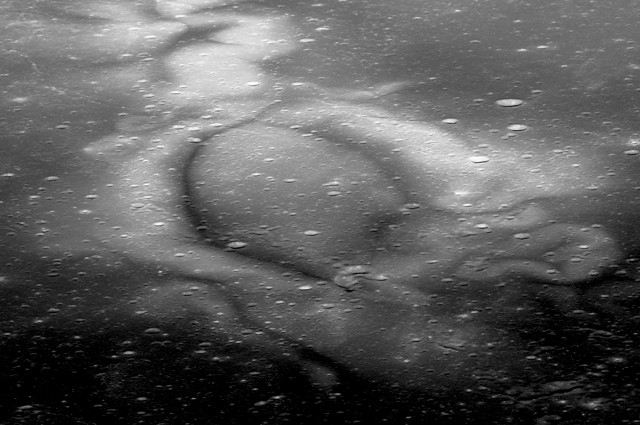
by Rachel Crowell Friday, December 21, 2018

The bright and dark shading characteristic of lunar swirls is seen in this oblique view looking east over the Reiner Gamma formation. The image was taken by the Lunar Reconnaissance Orbiter. Credit: NASA/Goddard Space Flight Center/Arizona State University.
Lunar observers have long noted mysterious “swirls,” patterns of alternating bright and dark shading, adorning the lunar surface. The popular Reiner Gamma formation — first described by Renaissance astronomers and now beloved by backyard astronomy enthusiasts — is one such lunar swirl.
The wispy-edged swirls typically alternate in brightness over distances of 1 to 5 kilometers and are found in clusters and as isolated features dozens of kilometers across. They look as if they’re almost painted onto the moon’s surface, and “seem to be unique to the moon — there’s no evidence of them anywhere else in the solar system,” says Douglas Hemingway, a planetary scientist at the Carnegie Institution for Science in Washington, D.C., and a co-author of a new study investigating the features published in the Journal of Geophysical Research: Planets.
Past lunar swirl research focused on understanding their relationship with space weathering. “Swirls are thought to form where local magnetic fields shield parts of the lunar surface from exposure to the solar wind or where those magnetic fields lead to sorting of some of the finest lunar soils,” wrote Hemingway, who was at the University of California, Berkeley, during the research, and his colleague, Sonia Tikoo of Rutgers University in New Jersey. In the new study, the researchers have discovered surprising connections between the swirls and the moon’s volcanic past.
Due to their association with local magnetic fields on the moon, which are themselves created by magnetized bodies of rock at or below the surface, lunar swirls serve as “optical magnetometers,” offering information about lunar magnetism at a finer scale than is available from magnetometers on lunar orbiting spacecraft, Hemingway says. He and Tikoo used this information to explore the size, shape, depth and magnetic strength of the bodies of rock responsible for the swirl-forming fields. They found that those bodies must be narrow — less than a few kilometers wide — and situated at shallow depths within a few kilometers of the moon’s surface, observations consistent with the notion that magnetized lava tubes or dikes are the source of these fields, the researchers reported. Additionally, the team’s analysis answers (at least in part) a long-standing question: “Why is it that swirls are found at many, but not all, of the localized crustal magnetic anomalies?”
A strong surface magnetic field — which is produced by highly magnetized rocks — is needed to generate the swirling patterns, according to the study. To achieve this extreme magnetization in lava tubes or dikes, something must have enhanced their magnetism, the authors wrote. It’s possible that the dikes or lava tubes originated from unusually iron-rich magmas, which passed this iron enrichment on to the resulting rocks, but Hemingway and Tikoo think a different process is responsible: thermochemical alteration of the surrounding host rock when the lava tubes or dikes were emplaced. Heat from intruding magma would bake the host rock, which could strengthen the magnetism from existing ferromagnetic grains in the rock and/or cause new such grains to form, the researchers suggested.
The study is interesting because its results align with one of several hypotheses for how the magnetic anomalies form, says David Blewett, a planetary geologist at Johns Hopkins University Applied Physics Laboratory who wasn’t involved in the work, but who studies lunar swirls using remote sensing methods. This work supports the idea that the magnetic anomalies “originate in volcanic or magmatic rocks that attained their magnetization … when the moon’s core was generating a dynamo field,” he notes. “The degree of magnetization implied by Hemingway and Tikoo’s calculations is much higher than that found in any lunar samples,” Blewett says, but the team addressed this problem. They cited experiments showing that when moon rocks are heated under lunar conditions, “the iron in certain minerals can be reduced to the metallic state, boosting the ability of the rock to carry a strong magnetization,” and uncovering “the exciting possibility” that the moon has rocks with higher metallic iron contents than have been previously observed, he says.
Understanding lunar swirls is important with respect to “a number of key issues in planetary science,” Blewett says, from how swirls interrupt the moon’s interactions with solar wind to clarifying the moon’s thermal history.
Additional mapping of the moon surface’s magnetic fields is the next step in this research, Hemingway says. And, he notes, a few research teams are exploring the potential use of either ultra-low orbiting spacecraft or rovers for this purpose.
© 2008-2021. All rights reserved. Any copying, redistribution or retransmission of any of the contents of this service without the expressed written permission of the American Geosciences Institute is expressly prohibited. Click here for all copyright requests.